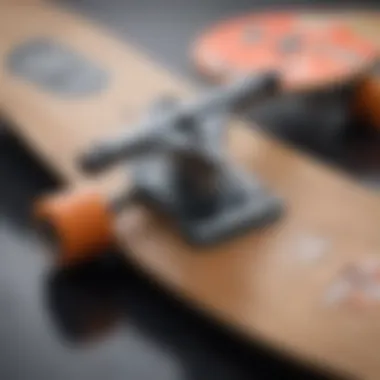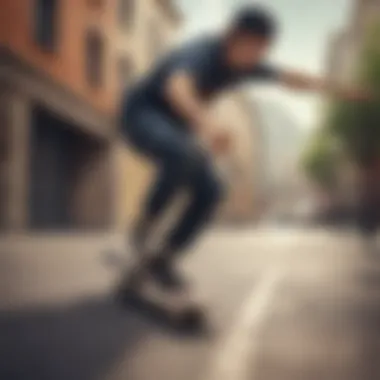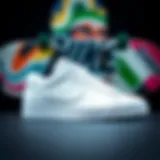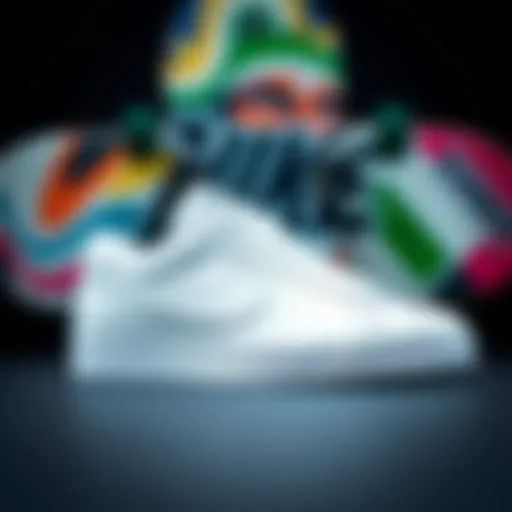Choosing the Right Skateboard Brand for Beginners


Intro
Skateboarding can be an exhilarating adventure, but diving into it as a beginner can be daunting. There are a myriad of brands out there, each offering distinct qualities and features. The choice you make will influence not only your initial experience but also your progression in the sport. In this guide, we’ll take a closer look at what makes a skateboard brand suitable for newcomers.
A brand’s reputation doesn’t just stem from sleek marketing or flashy graphics; it’s often rooted in the quality of materials and craftsmanship. Understanding these elements is vital. Are you looking for durability? Comfort? Perhaps you want a board that’s just right for performing tricks down the line. These considerations can either set you up for success or lead to frustration.
As we delve deeper into selecting the best skateboard for beginners, we will explore essential components, what to look for, and even some practical tricks to get you rolling smoothly.
Tricks and Techniques
When you first step onto a skateboard, the world can feel like a vast expanse of possibilities. But before you start trying to defy gravity with aerial stunts, it’s crucial to master the basics. One fundamental trick every skater should know is the heelflip. This trick not only showcases your skill but helps build confidence in handling your board.
Mastering the Heelflip
The heelflip is akin to the ol’ faithful of skateboarding tricks. To perform this move, position your back foot on the tail and your front foot near the middle of the board, with your toes hanging slightly off the edge. As you pop the tail down with your back foot, swiftly flick your front foot outward with your heel. The result? Your board should flip beneath you!
Don't worry if you don’t land it on the first few tries.
"Learning to skateboard is a journey—a process of trial and error. Be patient with yourself."
Tips for Consistent Landings
Achieving consistently good landings is often a matter of focus and practice. Here are a few tips:
- Look Down: As the board flips, keep your eyes on it. This will help you gauge when to land.
- Center Your Weight: Ensure you’re landing with your weight evenly distributed over both feet to maintain balance.
- Practice: Foot placement and flicking technique will improve with time. Don't rush it.
Skate Gear and Equipment
Choosing the right skateboard is more than just picking a brand. It’s about understanding components that influence your riding experience. Furthermore, wearing the appropriate safety gear can make a significant difference.
Choosing the Right Skateboard
As a beginner, a complete skateboard might be the best option. These boards come pre-assembled, offering a balance of quality and affordability. Some trusted brands to consider include:
- Element
- Santa Cruz
- Powell Peralta
- Almost
- Globe
When selecting, pay attention to the width of the board. Wider boards provide more stability, whereas narrower ones can help with tricks. Also, consider the material—maple wood decks are popular for their durability and responsiveness.
Essential Safety Gear for Skaters
No matter how spectacular the skateboard is, safety should always come first. Here’s what every beginner should wear:
- Helmet: A good helmet should fit snugly, protecting your head from falls.
- Wrist Guards: They safeguard against wrist injuries, especially during learning or trick attempts.
- Knee and Elbow Pads: These pads are essential for avoiding scrapes and bruises during your learning phase.
- Skate Shoes: Footwear designed for skateboarding offers better grip and support. Look for brands like Vans or Nike SB.
With the right gear and a skateboard that suits your style, you’re well on your way to carving your niche in the skating world. Remember, skateboarding is not just about the tricks—it's about enjoying the ride.
Understanding Skateboarding
Skateboarding is not just a sport; it’s a culture rich with history and creativity. At the core, understanding skateboarding involves grasping its evolution and appreciating the role of gear in ensuring an enjoyable experience. For those stepping onto a skateboard for the first time, knowing the fundamentals can dramatically affect their journey. Skipping this knowledge could mean missing out on both the technical aspects and the thrill that skateboarding offers.
The roots of skateboarding can be traced back to the 1950s in California, where surfers sought a way to practice their moves on land. This initial concept has transformed over decades into a complex sport with various styles and subcultures.
Here are several benefits of emphasizing a solid understanding of skateboarding:
- Cultural Appreciation: Understanding the sport’s rich legacy enhances a skateboarder’s engagement with the broader community.
- Skill Development: Knowing the mechanics of skating leads to better technique, making it easier for beginners to learn tricks.
- Safety Awareness: Familiarity with essential elements helps beginner skaters choose the right protective gear, minimizing risks of injury.
Whether it’s the history of deck designs or the evolution of skating techniques, a comprehensive grasp of the subject is foundational.


The Evolution of Skateboarding
The transformation of skateboarding reflects shifts in style, technology, and audience. It began as a simple means of replicating surfing on land and quickly escalated into a sport recognized internationally. Early skateboards were crudely fashioned wooden boards with roller skate wheels attached; today, manufacturers invest in high-tech materials and designs that enhance performance and safety.
Over the years, distinct styles emerged. Street skating gained traction in urban environments, pushing boundaries with creative maneuvers in concrete jungles. Vert skating, characterized by gravity-defying tricks performed on ramps, became a staple of skate parks. More recently, the rise of longboarding introduced versatility, appealing to those who prefer cruising over tricks.
The Importance of Choosing the Right Gear
When stepping onto a skateboard, selecting appropriate gear is crucial for both safety and skill development. The wrong board can hinder progress and, in some unfortunate cases, result in injury. Gear includes the skateboard itself, safety equipment like helmets and pads, and even the shoes worn while skating.
Key considerations when choosing gear:
- Durability: Novice skaters should seek boards made from high-quality materials that can withstand the wear and tear of learning.
- Fit and Comfort: Safety gear must fit correctly; loose helmets can slip off in a fall, while pads that are too tight can cause discomfort.
- Skill Alignment: The type of skateboard suited to a beginner may differ depending on whether they are interested in cruising or performing tricks.
In summary, whether one is drawn to the exhilarating world of skateboarding for leisure or sport, understanding its intricacies enriches the experience. By staying informed about the history, techniques, and essential gear, beginners can not only enjoy the thrill of skating but also navigate the challenges that come with it effectively.
Factors to Consider When Choosing a Beginner Skateboard
Selecting the right skateboard can feel like finding a needle in a haystack, especially for beginners. A skateboard is not just a piece of wood with wheels—it’s a gateway to a new world of thrills and creativity. Understanding which factors to consider when making a purchase is essential.
- Material Quality and Construction
The material of the skateboard and its construction play a critical role in performance. Most skateboards are made from maple wood due to its durability and flexibility. However, beginners might also see composite materials or even bamboo, which offer different advantages. Maple, for instance, provides a sturdy ride without compromising on weight, while bamboo can be lighter and more eco-friendly.
- Maple Wood: Offers strength and durability. Ideal for various tricks and stunts.
- Composite Materials: Generally lighter but can sometimes lack the strength needed for heavy tricks.
- Bamboo: Eco-friendly and lightweight, great for casual cruising but less suited for trick-heavy skating.
It’s not just about the material itself but how it’s constructed. Look for skateboards with multiple layers. This not only gives it a robust feel but also enhances its resilience against wear and tear. A well-constructed skateboard can save a novice from unnecessary replacements.
- Deck Size and Shape
The size and shape of the deck are pivotal in controlling the skateboard. A wider deck provides more stability, which is particularly beneficial for beginners learning basic balance and control. On the other hand, a narrower deck allows for more technical maneuvers but may require a bit more practice to master.
- Wide Decks (8.0" - 8.5"): Offer better balance and stability. Good for learning tricks and riding on various surfaces.
- Narrow Decks (7.5" - 8.0"): Advantageous for executing technical tricks but might pose a challenge for balance.
- Concave Shape: The deck curve affects foot grip and control; deeper concaves can help with trick performance, while milder concaves provide a sense of comfort for cruising.
Choosing a deck shape that fits your style can greatly enhance your skating experience. Consider trying a few out in a local skate shop to get a feel before making your choice.
- Wheel Hardness and Size
Wheels may seem like a minor detail, but they can drastically change how a skateboard performs. Wheel hardness is measured on a scale from 78A (soft) to 101A (hard), affecting grip and ride quality. - Trucks and Bearings
The trucks connect the wheels to the deck and play a vital role in maneuverability. As a beginner, you’d want precision and durability. Ideally, go for trucks made from aluminum, as they offer a balance between weight and strength.
- Soft Wheels (78A - 87A): Great for beginners. They provide a smoother ride over rough surfaces and offer good grip, enhancing stability when learning how to skate.
- Hard Wheels (88A - 101A): Best suited for smooth surfaces and tricks. They slide easier, which is advantageous for performing stunts.
- Wheel Diameter: A larger wheel gives more speed and a smoother ride, ideal for cruising. Smaller wheels help with tricks on flat surfaces but could be rough on rough terrain.
- Width of Trucks: They should match the width of your skateboard deck for optimal performance.
- Bushings: Look for soft bushings, which provide flexibility and comfort in turns.
Bearings are another crucial component. They allow the wheels to spin smoothly and directly impact the speed of the skateboard. ABEC ratings (from 1 to 9) give an indication of the bearing's precision and effectiveness. Opting for ABEC 5 or higher provides a decent speed and reliability for beginners.
Remember: Investing in a good-quality skateboard means fewer headaches down the road, allowing you to focus on getting the hang of skating rather than dealing with equipment failures.
Choosing the right skateboard requires careful consideration of various factors. The material, deck size, wheel hardness, and the toughness of trucks all contribute to the overall experience and performance. Taking the time to research these aspects can lead to a better, safer, and more enjoyable skating journey.
Top Skateboard Brands for Beginners
When it comes to skateboarding, the brand of skateboard you choose can significantly affect your experience. For beginners, opting for a reputable skateboard brand is crucial. These brands typically offer a balance of durability, comfort, and performance, which can enhance the learning process.
Selecting a skateboard from a well-known manufacturer means you can generally trust the quality of materials and construction. Also, major brands often provide good customer service and warranty options. These elements are invaluable, especially when you're just starting out.
Moreover, familiar brands tend to have a wealth of resources available online, including tutorials and communities, to help you along the way. This means you’re not just investing in a piece of equipment; you’re diving into a lifestyle rich with support and camaraderie.
Element Skateboards
Element Skateboards has carved a niche in the skateboarding world with a focus on sustainable practices and high-quality products. Their decks often utilize a unique mix of materials that not only offer strength but also create a lightweight feel, perfect for beginners who are still finding their footing.
The designs are often visually appealing and resonate with a young audience. Plus, Element places importance on eco-friendly manufacturing, appealing to environmentally-conscious skaters. If you’re someone who values quality products that reflect care for the planet, Element might be the brand for you.
Blind Skateboards


Blind Skateboards brings a blend of history and modern flair to the table. Established in the '80s, they’ve been a favorite among many skaters due to their reputation for durability and innovative designs. Their boards are designed to withstand the rigors of skating while still being comfortable for beginners.
The aesthetics are vibrant and often edgy, which could attract a younger demographic looking for style without compromising performance. The affordability factor is also notable, making them a solid choice for newcomers who are not ready to splurge.
Santa Cruz Skateboards
Santa Cruz Skateboards enjoys a legacy as one of the oldest skateboard brands still operating today. Their decks are well-crafted, giving a smooth ride that beginners will appreciate while they gain their balance. The brand is renowned for its creative graphics, making the boards visually interesting as well.
Furthermore, they offer a broad range of boards that cater to different skating styles, so as a beginner, you can find something that resonates with your personal taste. Santa Cruz maintains a reputation not just for quality but also for influencing skate culture throughout the years.
Baker Skateboards
Baker Skateboards is often associated with raw, street-smart designs that appeal to a fast-growing base of skaters. The brand was founded by pro skater Andrew Reynolds and has stuck around thanks to its unique style and solid gear. Their boards are designed robustly which can be appealing for beginners who may be a bit rough with their equipment.
The emphasis Baker places on skate culture and community connects well with young skaters. Their brand often focuses on promoting a carefree skating lifestyle, encouraging new skaters to embrace the fun side of skateboarding.
Penny Skateboards
Penny Skateboards is unique with their emphasis on plastic skateboards, or cruisers, that are lightweight and vivid in color. These boards are ideal for beginners who might feel a bit timid about traditional wooden boards. The small size and flexibility of Penny boards make them perfect for developing balance and maneuvering skills.
They offer a fun, casual approach to skateboarding, facing less pressure on performance output right off the bat. The mobility of these boards makes them excellent for quick commutes or casual rides, appealing to those who may not want a full-on skatepark experience from the get-go.
For beginners, choosing from these top skateboard brands can ease the transition into the world of skating. You’re not just purchasing an item; you’re embracing a lifestyle that values community, creativity, and, most importantly, personal growth on wheels.
Comparative Analysis of Popular Brands
In the world of skateboarding, selecting a brand can feel a bit like navigating a maze blindfolded. The right skateboard can drastically shape a beginner's journey, making the comparative analysis of popular brands not just beneficial, but essential. This analysis serves as a guiding star, illuminating the distinct characteristics and benefits each brand offers.
When considering a beginner skateboard, there are crucial factors that come into play, such as material quality, deck shape, and overall performance. Each brand brings a unique flair to these components, meaning a side-by-side comparison can help newcomers avoid costly missteps. It's not just about which skateboard looks cooler; it's about which one feels right under your feet and supports your growth.
Here’s a look at some of the most recognized brands:
Element vs. Blind
Element Skateboards has built a reputation on eco-friendliness and high performance. Their decks often come with a solid pop and durability, making them a favorite among many skaters. It’s almost like they whisper to you, "Let’s take some rad turns!" However, they might dip slightly into the higher price range, a consideration for budget-conscious newbies.
On the flip side, Blind Skateboards caters to a more affordable entry point. They provide decent quality without the hefty price tag, which is great for beginners who might still be uncertain about committing to the sport. Their designs feature colorful graphics too, which can really resonate with the youth vibe. So, if the cost is tight and you're just starting out, Blind might just hit the sweet spot for you.
Ultimately, the choice between Element and Blind often boils down to personal budget and the type of riding experience you're after.
Santa Cruz vs. Baker
Santa Cruz Skateboards carries a more storied legacy, being one of the oldest brands in the game. Their boards are well-engineered, often praised for their stability and durability. Newbies looking for a reliable platform to master their skills might find solace in Santa Cruz. These boards often have a wider selection of sizes, addressing various riding styles.
Now, Baker Skateboards offers an altogether different flavor. Known for their edgy aesthetics and a solid community around them, Baker often captures the rebellious spirit of skating. Their boards are designed with street skating in mind, making them a pragmatic choice for beginners who want to hit the pavement hard and fast. If you favor a bit of grit and creativity, Baker might speak to you more than Santa Cruz.
Penny vs. Traditional Skateboards
Penny Skateboards does things differently, often challenging the conventional aspects of skateboarding. Their plastic decks are lighter and typically come in bright colors that can attract a younger audience. Penny boards excel in portability, making them perfect for getting around town or just cruising smoothly through the park. However, they might lack the versatility for serious tricks.
Conversely, traditional skateboards, often made from hard maple, provide a sturdier framework ideal for tricks and jumps. They allow for more responsiveness and control underfoot. These boards might appear more intimidating at first, but they offer a much broader space for growth as a rider.
In short, while Penny boards are splendid for casual skating, those looking into pursuing tricks and skate parks may find traditional skateboards align better with their aspirations.
Cumulatively, this comparative analysis sheds light on the unique advantages and drawbacks of popular skateboard brands. Understanding these distinctions helps beginners forge a clearer path in their skateboarding journey.
Budget Considerations


When delving into the world of skateboarding, budget considerations stand as a crucial pillar for beginners. After all, your journey starts with finding a skateboard that suits both your aspirations and your wallet. Many novice skaters often view skateboarding as a niche sport, not realizing that selecting the right board doesn’t necessarily mean breaking the bank. The price range can vary significantly, but understanding what you can afford will guide you toward making a wise purchase.
Skateboards come in a multitude of price points, and this variation is largely tied to the quality of materials and the performance they offer. The good news is that you don’t have to sacrifice quality for affordability. By considering the right elements and benefits of budget-friendly options, you’ll discover that getting started in skateboarding can be both accessible and enjoyable.
Affordable Beginner Options
Finding the right skateboard that fits snugly within your budget doesn't need to feel like searching for a needle in a haystack. Many brands offer kits specifically tailored for beginners, often combining several essential components in one package.
- Popular Brands to Consider: Names like Element, Blind, and Baker are well-regarded in the beginner segment. They provide a range of options that cater to various price points.
- Completes vs. Custom Builds: For those who are just getting their feet wet in the skating scene, opting for complete skateboards is usually the way to go. These come fully assembled and save you the hassle of figuring out what parts to buy separately.
- Quality vs. Cost: With a budget-friendly complete skateboard, you can still maintain a satisfactory level of quality. For example, almost every skateboard you find in the affordable range will come with decent decks and wheels suitable for beginner use.
"Choosing the right beginner skateboard goes beyond the sticker price—it's about finding a balance between cost, quality, and your own comfort levels."
Investing in Quality for Long-Term Use
While the initial expense is critical, investing a bit more upfront can yield long-term benefits that enrich your skateboarding experience. A common pitfall is purchasing a very cheap skateboard that, while tempting, may not hold up through those early stages when you're mastering fundamental skills.
- Durability Matters: A costlier but high-quality skateboard will often feature better materials. For instance, decks made from maple may last longer than ones made from less sturdy materials. This means fewer repairs and replacements, which can save you money in the grand scheme.
- Resale Value: If you choose well-known brands, you can later resell your skateboard for a fair price, which can help offset initial costs. Brands like Santa Cruz maintain a strong market presence due to their reputation.
- Experience Improvement: Higher-end boards handle better. They give a more enjoyable ride, which in turn motivates you to skate more often and refine your skills. In skating, the right board can make all the difference in your confidence and progression.
In summary, while setting a budget is integral to any beginner's journey, knowing where to draw the line between affordability and quality can bring lasting enjoyment. Navigating these choices can seem daunting, but breaking it down into clear categories helps simplify the process and leads to a rewarding experience on two wheels.
Safety Gear and Practices
Ensuring safety while skateboarding might seem like a small detail, but it can genuinely make or break the experience for any beginner. Many new skaters dive headfirst into the thrill of skating without understanding the significant benefits safety gear provides. It's about striking a balance between excitement and safety. Gear can not only prevent injuries but also boost your confidence as you learn new tricks on your board. Feeling secure means you can focus better on perfecting your skating techniques, free from the worry of potential falls or accidents. Moreover, wearing proper safety gear normalizes protective practices in the skateboarding culture, encouraging others to think about their safety too.
Essential Safety Gear for Beginners
- Helmet
Probably the most crucial piece of equipment, a helmet protects your head during falls. Make sure it fits snugly and conforms to safety standards. Look for certifications like CPSC, which is a good indicator of quality. Don't go cheap on a helmet; your noggin deserves better! - Knee Pads
Knees take a pounding during those early skating days, especially when you’re learning how to balance or nail that first trick. Knee pads can absorb shock and reduce the chance of scrapes and bruises. It's like having a little cushion for your fall. - Elbow Pads
Just like knee pads, elbow pads offer protection against scrapes and impact. Whether you're grinding rails or just taking a tumble, these prevent nasty injuries that can sideline your skating journey. - Wrist Guards
Wrists are particularly vulnerable. When you fall, it’s instinctive to catch yourself with your hands. Wrist guards can help support your wrists and prevent sprains and fractures. They might not seem exciting, but they’re crucial for first-timers. - Proper Footwear
Good skate shoes are a must. Look for something with a flat sole for better grip on the board and padded support to ensure comfort while riding. Shoes designed for skateboarding can also provide durability that lasts longer against the grind of tricks.
@ If you’re going to invest in just one piece of safety gear, make it a quality helmet. Protect your head above all!
Having the right gear in place creates a strong foundation for safely enjoying the sport. Remember, it’s better to have it and not need it than to need it and not have it.
Practicing Safe Skating
Skateboarding may be exciting, but it’s vital to approach it with caution. Here are some principles to keep in mind as you step onto your board:
- Know Your Environment
Whether you’re skating in a park or the streets, be aware of your surroundings. Look out for pedestrians, cars, and any obstacles that might trip you up. Some areas might ban skateboarding, so scout ahead for spots that are safe and permissible. - Start Slow
It might be tempting to go for tricks right off the bat, but starting slow is key. Master the basics like balancing and pushing before attempting more challenging moves. Skating is a progression; take time to build your skills. - Skate With Friends
Having fellow skaters around can make the learning process fun and safer. Not only can they guide you, but they can also lend a hand in case of an accident. Plus, it’s always a good idea to have someone there who knows the safe spots. - Use Proper Techniques
Learning the right stance and foot placement can greatly reduce the chances of falling. Ensure you position yourself correctly when learning to brake or maneuver. Many resources, both online and in person, can help refine these skills. - Take Breaks
Don’t overdo it! Fatigue can lead to mistakes and accidents. Take breaks to recharge. It may sound simple, but staying fresh is essential for maintaining focus and precision.
Emphasizing safety isn’t about ruining the fun; it's about enhancing it. With the right protective gear and safe practices, beginners can enjoy their skateboard journey, navigating the exhilarating world of skateboarding without unnecessary risks.
Epilogue
When embarking on the journey of skateboarding, it is vital to grasp the significance of selecting the appropriate beginner skateboard brand. The right choice can make all the difference between a rewarding experience and one that feels cumbersome or frustrating. A skateboard is not just a board; it represents potential for creativity, expression, and even community engagement. Choosing a brand that aligns with one’s skill level, aspirations, and budget brings several crucial benefits.
The importance of understanding various brands lies in their unique characteristics and how they cater to different styles of skating. Each brand offers an array of options that can influence the performance and longevity of the skateboard. Furthermore, reliable brands tend to incorporate quality materials and innovative designs that can facilitate learning and growth. This is particularly pertinent for beginners who are still grasping the fundamentals.
In essence, the key considerations revolve around:
- Material quality and construction, enhancing durability.
- Deck size and shape to promote comfort and stability.
- Wheel hardness for appropriate traction and smoothness.
- Effective trucks and bearings to enable maneuverability.
The selection process should also resonate with individual preferences—this means liatining factors like aesthetics, brand reputation, and color choices. Thus, novices are encouraged to take their time exploring options and seeking advice from experienced skaters or local shops.
As we wrap up this comprehensive exploration of selecting a beginner skateboard brand, consider it not just a tactile choice but also one that influences how you experience this exhilarating sport. Choosing wisely lays the foundation for skill development and enjoyment for years to come.
Summary of Key Points
- Importance of Choosing the Right Brand: Selecting the right skateboard brand is essential for a positive initial experience.
- Material and Quality: Solid construction materials affect the skateboard’s resilience and longevity.
- Personalization: Individual preferences should be considered in addition to fundamental attributes of the skateboard.
- Skill Development: A well-chosen board can ease the learning curve, allowing for a more pleasurable skating journey.
- Safety Considerations: Ensure that safety gear is aligned with the skateboard choice, enhancing overall protection.
Final Recommendations for Beginners
For those just starting with skateboarding, it is recommended to take the plunge with reputable brands such as Element Skateboards or Santa Cruz Skateboards. They not only provide reliable and quality products but also have a variety of options tailored for beginners. Here are a few tips:
- Test Before You Invest: If possible, visit a local skate shop to feel different decks and get used to their weight and shape.
- Look for Complete Kits: Beginners may find value in complete skateboard kits that guarantee compatibility and often include necessary components like wheels and trucks.
- Join Local Skate Communities: Engaging with skateboards enthusiasts can provide insights and trustworthy recommendations based on real-world experience.
- Prioritize Comfort and Fit: Your skateboard should feel natural and intuitive while riding.
- Be Patient: Mastery takes time, so don't rush the learning process. Find a board that resonates with your style and stick with it to grow your skills.
In summary, an informed selection can significantly enhance one’s skateboarding experience, encouraging enthusiasts not only to ride safely but also to revel in the journey of learning and improvement.



